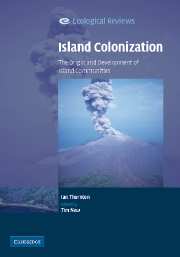Book contents
- Frontmatter
- Contents
- Editorial preface
- Acknowledgements
- PART I Theoretical and experimental studies
- PART II Natural recolonization after devastation
- PART III The recolonization of devastated islands
- PART IV Assembly of biotas on new islands
- 9 Lake Wisdom: a new island of fresh water
- 10 New islands in the sea
- 11 Anak Krakatau, Krakatau's child, b. 1933
- 12 Surtsey, Island of Surtur, b. 1963
- 13 Motmot: an emergent island in fresh water
- PART V Colonization and assembly
- References
- Index
11 - Anak Krakatau, Krakatau's child, b. 1933
Published online by Cambridge University Press: 12 January 2010
- Frontmatter
- Contents
- Editorial preface
- Acknowledgements
- PART I Theoretical and experimental studies
- PART II Natural recolonization after devastation
- PART III The recolonization of devastated islands
- PART IV Assembly of biotas on new islands
- 9 Lake Wisdom: a new island of fresh water
- 10 New islands in the sea
- 11 Anak Krakatau, Krakatau's child, b. 1933
- 12 Surtsey, Island of Surtur, b. 1963
- 13 Motmot: an emergent island in fresh water
- PART V Colonization and assembly
- References
- Index
Summary
Birth and early physical development
In 1930 an island broke the surface of the sea covering the submerged caldera resulting from Krakatau's 1883 eruption (Fig. 3.3, p. 38). It appears to have been built up from a vent that was about halfway between the two main vents of the 1883 eruption, and is almost certainly the product of the same magma chamber. Unfortunately, as was the case after the 1883 Krakatau eruption, the opportunity to study the very early steps in the processes of animal colonization and community assembly was again missed. There have been a number of intensive studies on the island in recent years, however.
The biota of the young active island volcano was evidently devastated by the eruptions of 1952–53 (van Borssum Waalkes 1954) and there have been several severe eruptions since. Such events have provided further opportunities of monitoring the early stages of the assembly and development of a tropical forest island ecosystem on the island. In this case the colonists presumably originated on Anak Krakatau's three older companion islands, themselves in process of recovery from the 1883 eruption. Since a nested pair of natural experiments in colonization was now in progress at the same site, the experiments having started several decades apart, a number of comparative studies became possible (Thornton et al. 1992). Anak Krakatau's continuing volcanic activity, which had no counterpart on Rakata (or on Surtsey), has complicated comparisons of biotic assembly by imposing periodic checks (to varying extents) on the successional processes occurring on the island, but it has also provided replicate sequences of succession from zero or near-zero base-lines.
- Type
- Chapter
- Information
- Island ColonizationThe Origin and Development of Island Communities, pp. 148 - 156Publisher: Cambridge University PressPrint publication year: 2007



